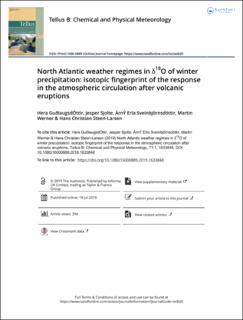North Atlantic weather regimes in δ18O of winter precipitation: isotopic fingerprint of the response in the atmospheric circulation after volcanic eruptions
GudlaugsdOttir, Hera; Sjolte, Jesper; Sveinbjörnsdóttir, Árny Erla; Werner, Martin; Steen-Larsen, Hans Christian
Journal article, Peer reviewed
Published version

Åpne
Permanent lenke
https://hdl.handle.net/11250/2721299Utgivelsesdato
2019Metadata
Vis full innførselSamlinger
- Geophysical Institute [1198]
- Registrations from Cristin [9791]
Originalversjon
10.1080/16000889.2019.1633848Sammendrag
Equatorial volcanic eruptions are known to impact the atmospheric circulation on seasonal time scales through a strengthening of the stratospheric zonal winds followed by dynamic ocean-atmosphere coupling. This emerges as the positive phase of the North Atlantic Oscillation in the first 5 years after an eruption. In the North Atlantic, other modes of atmospheric circulation contribute to the climate variability but their response to volcanic eruptions has been less studied. We address this by retrieving the stable water isotopic fingerprint of the four major atmospheric circulation modes over the North Atlantic (Atlantic Ridge, Scandinavian Blocking and the negative and positive phases of the North Atlantic Oscillation (NAO − and NAO+)) by using monthly precipitation data from Global Network of Isotopes in Precipitation (GNIP) and 500 mb geo-potential height from the 20th Century Reanalysis. The simulated stable isotopic pattern of each atmospheric circulation mode is further used to assess the retrieved pattern. We test if changes in the atmospheric circulation as well as moisture source conditions as a result of volcanic eruptions can be identified by analyzing the winter climate response after both equatorial and high-latitude North Hemispheric volcanic eruptions in data, reanalysis and simulations. We report of an NAO + mode in the first two years after equatorial eruptions followed by NAO − in year 3 due to a decrease in the meridional temperature gradient as a result of volcanic surface cooling. This emerges in both GNIP data as well as reanalysis. Although the detected response is stronger after equatorial eruptions compared to high latitude eruptions, our results show that the response after high latitude eruptions tend to emerge as NAO − in year 2 followed by NAO + in year 3–4.
